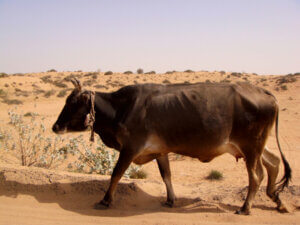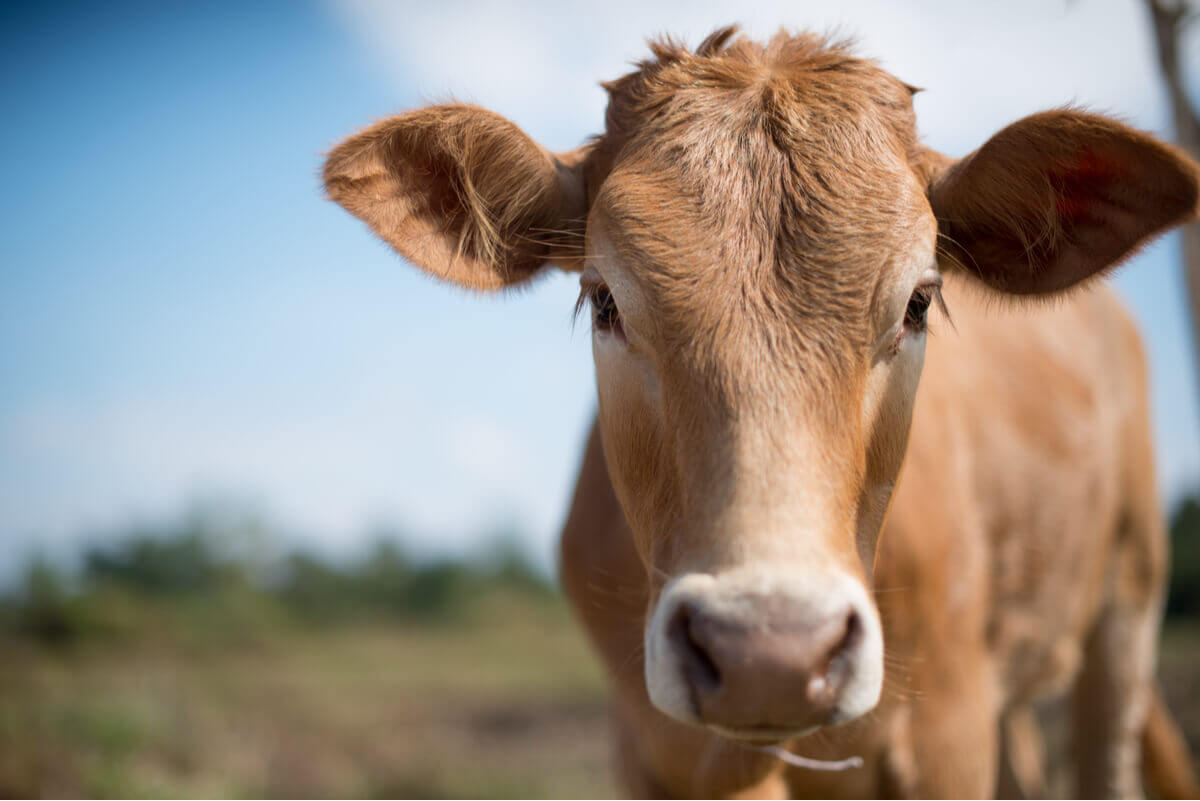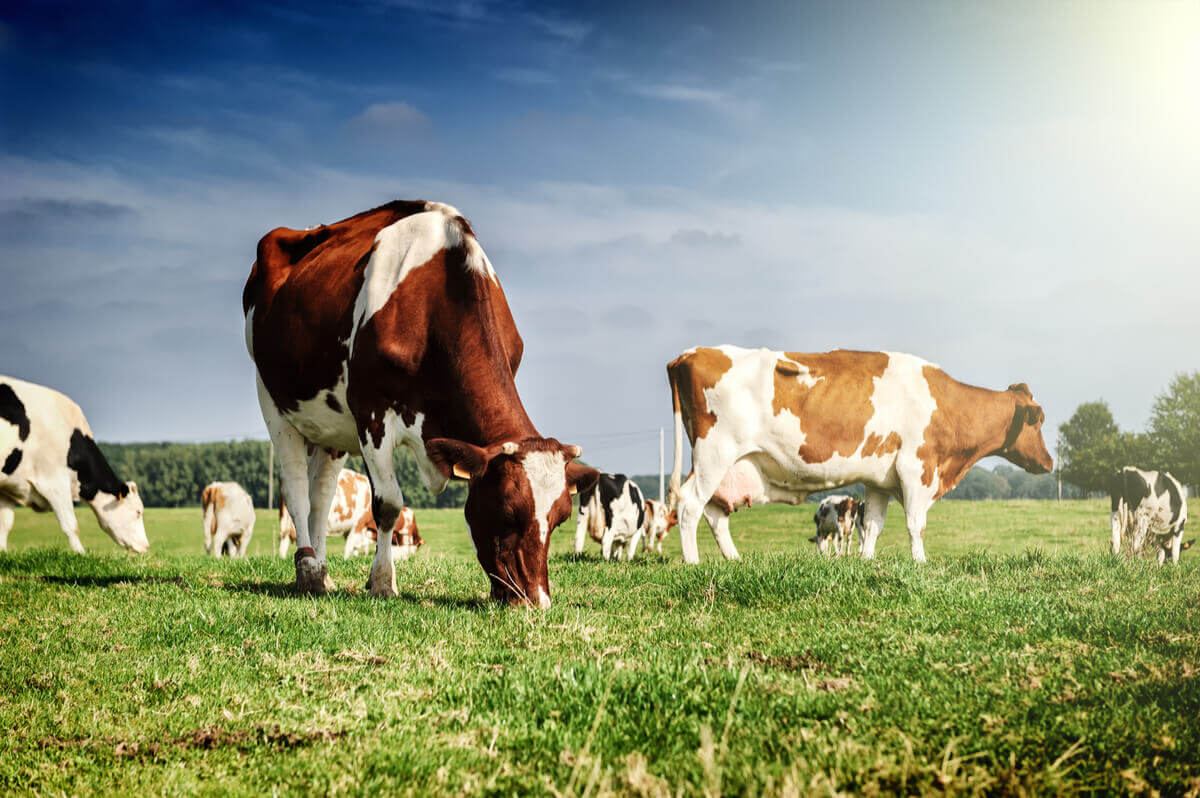The Acclimation Capacity of Animals and How it Influences Farmers’ Choices


Written and verified by the vet Érica Terrón González
This practical example will help you understand why animals need to acclimatize. A breed of cattle from India will adapt more easily to a warm climate than continental breeds from temperate Europe. For animals to thrive, they need to achieve what’s known as thermal balance. Find out about the acclimation capacity of animals.
Due to this, farmers analyze the climatic characteristics of their area and, consequently, choose one breed over another. An animal that doesn’t suffer from heat stress is more likely to stay healthy, which is something that every responsible farmer seeks.
The acclimation capacity of animals
Based on their thermoregulatory capacity, vertebrate animals are classified into two broad categories. We’ll explain them below:
Poikilotherms, also called ectotherms or cold-blooded animals
Amphibians, reptiles, and fish, whose body temperature varies and depends on the environmental conditions. In short, these living beings lack thermoregulatory mechanisms.
Homeotherms or warm-blooded animals
Most domestic animals fall into this group, as they have an effective thermoregulatory system. This system is quite complex, especially in mammals, which have many regulatory mechanisms.
Some of these mechanisms are physical, such as vasodilation or sweating, while others are chemical, such as hormonal and metabolic variations.

Thermoregulation: production and dissipation of body heat
In warm environments, animals need to be able to regulate their temperature and eliminate heat, both the heat produced inside them and the heat they receive from the environment. Otherwise, their temperature would rise uncontrollably, and this could lead to death.
To avoid this, living beings must achieve a thermal balance, meaning that the heat generated and dissipated must be equal. An animal produces heat in several ways:
- Firstly, because it gets it from its environment, due to solar radiation or high outdoor temperatures.
- Secondly, because its body produces it, through basal metabolism, digestion, muscle activity, and many other metabolic processes.
To dissipate this stored heat, the animal uses different evaporation, radiation, convection, or conduction mechanisms. They’re all effective, as long as the ambient temperature is low enough.
For this reason, when the ambient temperature exceeds the body temperature, thermoregulatory mechanisms begin to fail. An animal that isn’t acclimatized to the environment isn’t able to cope with this.
The acclimation capacity of animals: cattle
Animals absorb the energy from solar radiation. In some cases, this equals or exceeds the energy expenditure basal metabolism produces. Many factors influence this heat absorption in bovine species.
For example, cows with dark coats absorb much more energy than cows with light-colored coats. This is why light- and bright-colored breeds are the most appropriate for hot and humid tropical and subtropical climates. On the contrary, dark-coated breeds are best for high altitudes, since the temperature is lower and the animals need to absorb as much heat as possible.
Desert-adapted cattle have lighter fur on their abdomen, as well as longer limbs. This allows their body to be as protected as possible from the heat of the ground.
Effect of fur on heat transfer
Broadly speaking, cows have two types of hair:
- Firstly, short hair, which consists of primary hair follicles that have associated sweat glands. They excrete more water through sweat and, with it, “excess” temperature. This is the coat that’s typical of breeds acclimated to warm environments.
- Secondly, long, woolly hair, which consists of primary and secondary follicles, with fewer or smaller sweat glands. It’s typical of continental livestock. This fur creates an insulating layer between the skin and the external environment, allowing it to absorb humidity and maintain temperature. Ideal for cold climates; deadly in hot climates.
The importance of sweating in the acclimation capacity of animals
Sweat glands play a fundamental role in dissipating heat. It influences both its quantity, as well as its location and type. For example, sweat is the most common form of evaporative thermoregulation in cows. In fact, it’s even more common than panting, which other domestic animals use to a greater extent.
An animal’s skin type determines how many sweat glands it has. More important than quantity is for these glands to be located closer to the surface. For example, in the zebu.
Cow size and structure
Animals acclimatized to warm areas have much thinner bodies, with a greater distance between the withers and the sternum, and a raised belly. This structure adapts more easily to high temperatures because it has a larger body surface area. Thus, it allows animals to be able to dissipate more heat.

The acclimation capacity of animals and how it influences farmers’ choices
Thanks to the available information, we know that a forward-thinking farmer must take many factors into account when it comes to choosing their cattle based on their geographical location.
In short, the size of the animal, its structure, the length of its hair, and its color all influence its thermoregulation ability. Only an animal that’s capable of achieving thermal balance will survive in extreme temperature climates.
This practical example will help you understand why animals need to acclimatize. A breed of cattle from India will adapt more easily to a warm climate than continental breeds from temperate Europe. For animals to thrive, they need to achieve what’s known as thermal balance. Find out about the acclimation capacity of animals.
Due to this, farmers analyze the climatic characteristics of their area and, consequently, choose one breed over another. An animal that doesn’t suffer from heat stress is more likely to stay healthy, which is something that every responsible farmer seeks.
The acclimation capacity of animals
Based on their thermoregulatory capacity, vertebrate animals are classified into two broad categories. We’ll explain them below:
Poikilotherms, also called ectotherms or cold-blooded animals
Amphibians, reptiles, and fish, whose body temperature varies and depends on the environmental conditions. In short, these living beings lack thermoregulatory mechanisms.
Homeotherms or warm-blooded animals
Most domestic animals fall into this group, as they have an effective thermoregulatory system. This system is quite complex, especially in mammals, which have many regulatory mechanisms.
Some of these mechanisms are physical, such as vasodilation or sweating, while others are chemical, such as hormonal and metabolic variations.

Thermoregulation: production and dissipation of body heat
In warm environments, animals need to be able to regulate their temperature and eliminate heat, both the heat produced inside them and the heat they receive from the environment. Otherwise, their temperature would rise uncontrollably, and this could lead to death.
To avoid this, living beings must achieve a thermal balance, meaning that the heat generated and dissipated must be equal. An animal produces heat in several ways:
- Firstly, because it gets it from its environment, due to solar radiation or high outdoor temperatures.
- Secondly, because its body produces it, through basal metabolism, digestion, muscle activity, and many other metabolic processes.
To dissipate this stored heat, the animal uses different evaporation, radiation, convection, or conduction mechanisms. They’re all effective, as long as the ambient temperature is low enough.
For this reason, when the ambient temperature exceeds the body temperature, thermoregulatory mechanisms begin to fail. An animal that isn’t acclimatized to the environment isn’t able to cope with this.
The acclimation capacity of animals: cattle
Animals absorb the energy from solar radiation. In some cases, this equals or exceeds the energy expenditure basal metabolism produces. Many factors influence this heat absorption in bovine species.
For example, cows with dark coats absorb much more energy than cows with light-colored coats. This is why light- and bright-colored breeds are the most appropriate for hot and humid tropical and subtropical climates. On the contrary, dark-coated breeds are best for high altitudes, since the temperature is lower and the animals need to absorb as much heat as possible.
Desert-adapted cattle have lighter fur on their abdomen, as well as longer limbs. This allows their body to be as protected as possible from the heat of the ground.
Effect of fur on heat transfer
Broadly speaking, cows have two types of hair:
- Firstly, short hair, which consists of primary hair follicles that have associated sweat glands. They excrete more water through sweat and, with it, “excess” temperature. This is the coat that’s typical of breeds acclimated to warm environments.
- Secondly, long, woolly hair, which consists of primary and secondary follicles, with fewer or smaller sweat glands. It’s typical of continental livestock. This fur creates an insulating layer between the skin and the external environment, allowing it to absorb humidity and maintain temperature. Ideal for cold climates; deadly in hot climates.
The importance of sweating in the acclimation capacity of animals
Sweat glands play a fundamental role in dissipating heat. It influences both its quantity, as well as its location and type. For example, sweat is the most common form of evaporative thermoregulation in cows. In fact, it’s even more common than panting, which other domestic animals use to a greater extent.
An animal’s skin type determines how many sweat glands it has. More important than quantity is for these glands to be located closer to the surface. For example, in the zebu.
Cow size and structure
Animals acclimatized to warm areas have much thinner bodies, with a greater distance between the withers and the sternum, and a raised belly. This structure adapts more easily to high temperatures because it has a larger body surface area. Thus, it allows animals to be able to dissipate more heat.

The acclimation capacity of animals and how it influences farmers’ choices
Thanks to the available information, we know that a forward-thinking farmer must take many factors into account when it comes to choosing their cattle based on their geographical location.
In short, the size of the animal, its structure, the length of its hair, and its color all influence its thermoregulation ability. Only an animal that’s capable of achieving thermal balance will survive in extreme temperature climates.
All cited sources were thoroughly reviewed by our team to ensure their quality, reliability, currency, and validity. The bibliography of this article was considered reliable and of academic or scientific accuracy.
- Metabolismo basal [Internet]. Es.wikipedia.org. [cited 14 December 2020]. Available from: https://es.wikipedia.org/wiki/Metabolismo_basal
- Bos primigenius indicus [Internet]. Es.wikipedia.org. [cited 14 December 2020]. Available from: https://es.wikipedia.org/wiki/Bos_primigenius_indicus
- Nazar Anchorena J. Adaptación del ganado vacuno a zonas cálidas [Internet]. Brangus; 1980 [cited 14 December 2020]. Available from: http://produccion-animal.com.ar/clima_y_ambientacion/18-adaptacion_a_zonas_calidas.pdf
This text is provided for informational purposes only and does not replace consultation with a professional. If in doubt, consult your specialist.








